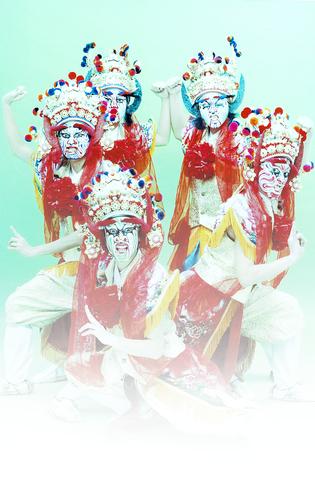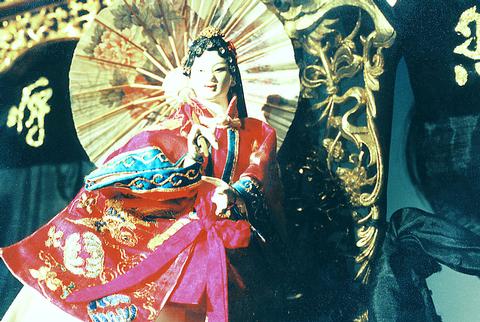While Taiwan's national soccer team -- currently standing at 172nd place in the FIFA rankings, between Cambodia and Tonga -- won't be taking part in this years World Cup, a squad of dancers, Aborigines, martial arts experts and puppeteers will be flying to Korea to participate in the quadrennial international soccer extravaganza.
Needless to say, the traditional arts enthusiasts will not be taking to the pitch kitted out in the latest in sweat-absorbent sporting attire, nor will they be bending it like Beckham. Instead, the Taiwan Culture and Arts Delegation (

PHOTOS COURTESY OF IOV
Divided into three categories -- general folk arts, puppet theater and mask arts -- the series of festivals has been organized by the city governments of Incheon, Daejeon and Seoul, respectively. Although running concurrently with the World Cup, the festivals are not official FIFA events.

Regardless of the festivals' non-official status, however, organizers have managed to enlist the help of traditional folk arts groups from 26 countries thus far. And, like Taiwan, not all of the nations taking part in the festivities are known for their soccer prowess.
"We're well aware of the lack of soccer in Taiwan. Because the World Cup is being held in Asia for the first time, however, organizers of the art festivals wanted to showcase Asian folk arts," said Caroline Kuo (郭麗敏), an executive with the International Organization of Folk Art Taiwan (IOV).

"Along with Taiwan, representatives of folk art from other non-competing nations such as Indonesia and Thailand will also be there. The festivals are a celebration of folk art rather than soccer." Representing Taiwan at the 2002 FIFA World Cup International Arts Festivals are members of the Taipei Physical Education College Dance Troupe (
Selected by a group of highly-respected scholars of traditional arts that included Lin Mao-chien (
"We were informed of the events last year, and started looking around almost immediately for groups to send," Kuo said. "Because of the prestige surrounding the festivals, however, we decided to let local scholars choose the groups they felt best exemplified Taiwanese traditional arts rather than simply asking arts groups to send in proposals as we have done in the past."
Taking to the stage at the largest of the three festivals, The Incheon International Arts Festival, will be a squad from the Taipei Physical Education College Dance Troupe along with three members of the Panay Indigenous Culture and Arts Group.
According to Kuo, the idea to combine the two troupes was to allow for more contrast and a more varied program. As a result, the combined troupe will be performing four very different routines in Incheon. The routines include religious folk and aboriginal dance, martial arts along with diabolo playing and shuttlecock kicking.
"As the World Cup is an international event, we wanted a special and varied program. In order to achieve this we started preparing for the festival about six months ago," said choreographer Tsai Li-hua (蔡麗華). "Along with the dance routines, which are very traditional, we've also included an exhibition of martial arts based on the movie Crouching Tiger, Hidden Dragon.
Representing the nation at the Daejeon International Puppet Theater Festival is the renowned I-Wan-Jan Puppet Theater. Established in 1931, the puppet-theater is one of Taiwan's oldest and one of the few to excel in a variety of fields of traditional puppetry. The troupe is well known for its ability to perform both Nankuan (
For the Korean shows, I-Wan-Jan will be performing a centuries-old show entitled A Chance Encounter Leads to Marriage (
Telling of a love triangle between a gifted martial arts fighter, a nefarious young man and a ravishingly beautiful young maiden, the show combines all the ingredients of a gritty soap opera with plenty of martial arts action.
While the troupes' upcoming trip to Korea is not the first time puppet master Li Chuang-tsian (
"It's obviously a great honor to have been invited to participate in the festival and we are looking forward to both performing and exchanging views with traditional arts groups from around the world," Li said. "What will be tough is pleasing the audiences. Unlike other puppet festivals where the audience more often than not knows something about puppet theater, the shows in Korea will see very diverse audiences."
The most colorful of the arts groups, however, will be appearing in Seoul.
Representing Taiwan at the Seoul International Mask Arts Festival is the Na-Cha Studio of Traditional Arts.
Formed by Kao Chih-hung (高志宏) in the mid-1990s, the group is one of the nation's leading groups specializing in temple procession arts. For its shows, Kao has opted to perform God Commands (官將首) and God General Troupe (神將團), two colorful and acrobatic routines that are employed in Taiwan in order to dispel evil spirits.
"To be part of this international gathering is quite something. And as we are performing in the capital we will have to doubly ensure we perform to the very best of our ability," said Kao. "We only hope we have chosen a program that exemplifies Taiwan and is accessible to those with a knowledge of religious art as well as to those without." While none of the members of Taiwan's traditional arts delegation had an idea which nation will prove victorious on the pitch, they were all fully aware of, and had aired their concerns about being caught up in soccer related violence off the pitch.
"Thankfully we're not going to meet with any English fans, but we have been warned about possible trouble at some matches," Kuo said. "At a meeting earlier this week we asked the performers to be careful and think about staying in their hotels when France plays Denmark and Korea plays Portugal."

The canonical shot of an East Asian city is a night skyline studded with towering apartment and office buildings, bright with neon and plastic signage, a landscape of energy and modernity. Another classic image is the same city seen from above, in which identical apartment towers march across the city, spilling out over nearby geography, like stylized soldiers colonizing new territory in a board game. Densely populated dynamic conurbations of money, technological innovation and convenience, it is hard to see the cities of East Asia as what they truly are: necropolises. Why is this? The East Asian development model, with

June 16 to June 22 The following flyer appeared on the streets of Hsinchu on June 12, 1895: “Taipei has already fallen to the Japanese barbarians, who have brought great misery to our land and people. We heard that the Japanese occupiers will tax our gardens, our houses, our bodies, and even our chickens, dogs, cows and pigs. They wear their hair wild, carve their teeth, tattoo their foreheads, wear strange clothes and speak a strange language. How can we be ruled by such people?” Posted by civilian militia leader Wu Tang-hsing (吳湯興), it was a call to arms to retake

This is a deeply unsettling period in Taiwan. Uncertainties are everywhere while everyone waits for a small army of other shoes to drop on nearly every front. During challenging times, interesting political changes can happen, yet all three major political parties are beset with scandals, strife and self-inflicted wounds. As the ruling party, the Democratic Progressive Party (DPP) is held accountable for not only the challenges to the party, but also the nation. Taiwan is geopolitically and economically under threat. Domestically, the administration is under siege by the opposition-controlled legislature and growing discontent with what opponents characterize as arrogant, autocratic

When Lisa, 20, laces into her ultra-high heels for her shift at a strip club in Ukraine’s Kharkiv, she knows that aside from dancing, she will have to comfort traumatized soldiers. Since Russia’s 2022 invasion, exhausted troops are the main clientele of the Flash Dancers club in the center of the northeastern city, just 20 kilometers from Russian forces. For some customers, it provides an “escape” from the war, said Valerya Zavatska — a 25-year-old law graduate who runs the club with her mother, an ex-dancer. But many are not there just for the show. They “want to talk about what hurts,” she